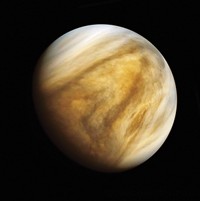Advertisement
Grab your lab coat. Let's get started
Welcome!
Welcome!
Create an account below to get 6 C&EN articles per month, receive newsletters and more - all free.
It seems this is your first time logging in online. Please enter the following information to continue.
As an ACS member you automatically get access to this site. All we need is few more details to create your reading experience.
Not you? Sign in with a different account.
Not you? Sign in with a different account.
ERROR 1
ERROR 1
ERROR 2
ERROR 2
ERROR 2
ERROR 2
ERROR 2
Password and Confirm password must match.
If you have an ACS member number, please enter it here so we can link this account to your membership. (optional)
ERROR 2
ACS values your privacy. By submitting your information, you are gaining access to C&EN and subscribing to our weekly newsletter. We use the information you provide to make your reading experience better, and we will never sell your data to third party members.
Astrochemistry
Venus has a more complex atmosphere than scientists thought
New information about nitrogen concentrations could change Venusian atmosphere models and influence how we study exoplanets
by Sam Lemonick
April 23, 2020
| A version of this story appeared in
Volume 98, Issue 16

Spacecraft first measured the chemical makeup of Venus’s atmosphere in the 1960s. By the late 1970s, scientists agreed that available data suggested the Venusian atmosphere was uniformly 3.5% nitrogen gas up to 100 km above the surface. A new analysis of data collected from the planet’s atmosphere in 2007 has found N2 concentrations 40% higher than expected. The findings could lead to revised models of Venusian chemical and physical processes and could even influence how scientists study exoplanets (Nat. Astron. 2020, DOI: 10.1038/s41550-020-1079-2).
“Venus is the nearest planet to Earth but it’s one of the planets we know the fewest things about,” says Stephen Kane of the University of California, Riverside, an exoplanet researcher who wasn’t involved in the study. Because of that lack of data—especially direct measurements of chemicals in Venus’s atmosphere at different altitudes—he says he’s not surprised that existing atmospheric models are incomplete. But he says the results underscore the need for more missions to Venus so scientists can better understand its atmosphere’s physical and chemical processes.
The data for the new analysis came from a neutron spectrometer on NASA's Messenger spacecraft. In 2007, the craft passed through Venus’s atmosphere on its way to Mercury. The Venus excursion allowed scientists to test the neutron spectrometer before it collected data on the composition of Mercury’s surface, says Patrick Peplowski of Johns Hopkins University, who led that project and the new research. In the years since that mission, his group found a 1962 research paper showing that neutron measurements could be used to calculate N2 concentrations because the gas absorbs low-energy neutrons. So the scientists decided to reanalyze the data collected during Messenger’s trip through the Venusian atmosphere.
They found that N2 made up about 5% of the atmosphere at around 70 km above the planet’s surface. Peplowski says that models of Venus’s atmosphere are based on what scientists know of Earth’s atmosphere, where wind and convection currents create an even mixture of gases up to a certain altitude. On Venus, that altitude was thought to be about 100 km. The new analysis suggests N2 levels jump at about 50 km. “There really aren’t any models out there that account for this,” Peplowski says.
Venus models are of particular interest to exoplanet researchers like Kane. Its thick atmosphere and proximity to the Sun make it similar to some of the exoplanets that scientists hope to study with the next generations of space-based telescopes. But those telescopes will only be able to measure the tops of exoplanet atmospheres, so drawing inferences about their overall composition will require accurate models. What’s more, Kane says, scientists will soon begin designing exoplanet-analyzing instruments for future telescopes. They’ll make decisions about specifications like what wavelengths to monitor based on models such as the ones we have of Venus.
Peplowski and Kane both hope that future Venus missions will measure its atmospheric makeup directly. No missions are currently scheduled. “We need to have another probe down to the surface,” Kane says.





Join the conversation
Contact the reporter
Submit a Letter to the Editor for publication
Engage with us on Twitter